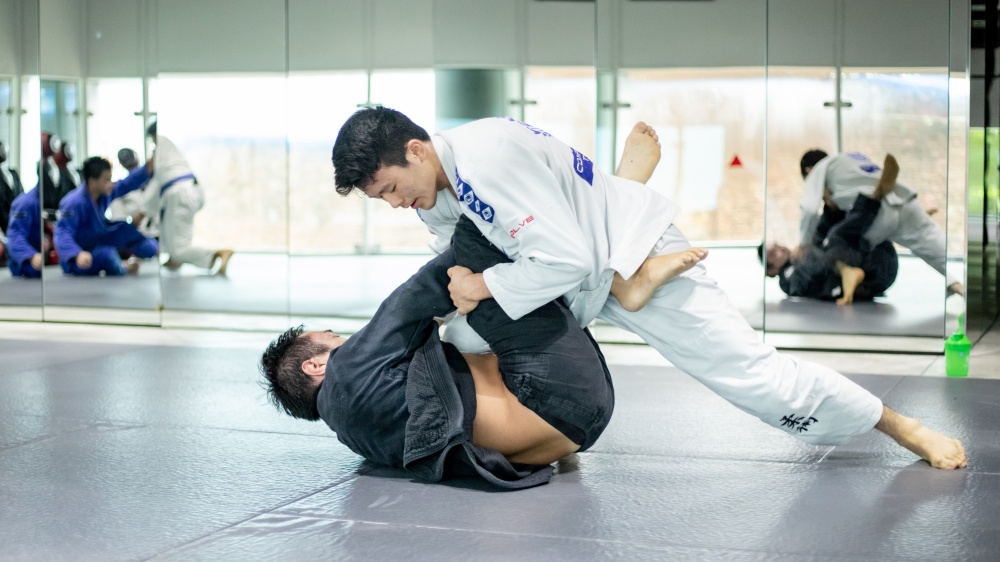It is not uncommon to see teammates with different BJJ games. This is because one’s personal style depends on many factors, such as size, age, and even personality. This is also the case in passing the guard. It is important to look at your unique physical attributes and use techniques that complement them.
There are two basic types of guard passing: speed and pressure. Smaller and agile grapplers are more inclined to use speed passing, whereas bigger and heavier grapplers will get more out of using pressure to pass the guard.
Both styles work well and will work even at the championship level. In this article, we will talk about a type of pressure passing in BJJ called the leg weave pass.
Pressure Passing In BJJ
Gi BJJ offers additional grips that can be used to control the opponent as you transition to better positions. The gi serves many purposes, but its primary benefit is adding a layer of control. In no-gi BJJ, athleticism plays a significant role. It is more dynamic; therefore, being strong and fast is emphasized.
When passing in no-gi, connections are limited, and it can be difficult to restrain your opponent once they become sweaty. Positional control is essential in grappling. If you can limit your opponent’s movements, it is easier to be on the offensive.
Brazilian Jiu-Jitsu has evolved a lot during the past decades. This is especially the case with guardwork. The modern approach to guards is highly nuanced, and one mistake on the passer’s part can lead to disaster.
In order to be successful in today’s game, you must adapt your game to the ever-changing meta. Using pressure passing is an excellent way to stay competitive against modern guard players. Pressure passing helps you control space. It limits your opponent’s options because you can leverage gravity to pin them down on the mat.
Controlling the opponent’s body using your weight makes framing and guard retention very difficult. As a result, you’ll be able to grind your opponent down and eventually pass the guard.
The Basic Leg Weave Pass
The leg weave pass, also called the hip smash, is a type of pressure pass that depends on properly pinning the opponent’s hips using your bodyweight as you attempt to work past their legs. Like other pressure passes, this pass requires good weight distribution, timing, and control as you advance your position.
Since this passing style does not require much athleticism, it is an excellent technique for grapplers who are getting up there in age. It can contain even the most athletic of training partners when executed well.
This pass is highly effective once you pin the hip and move at an angle to pass. Commonly seen in situations where the bottom player puts up a knee shield from half guard, guard passers can weave their arm through the opponent’s leg to pin down the knee shield and move towards the opponent’s head to pass the guard. Let’s watch this video by Lachlan Giles as he shows how to perform the leg weave pass in the gi.
The best time to use the leg weave pass is when the opponent has a knee shield. This pass works best in the gi but can also work well in no-gi.
To start, assuming the opponent has a knee shield, weave your arm around the opponent’s raised leg until you grip their bottom leg. Control the upper body by grabbing the opponent’s lapel or sleeve using your other arm. Free your trapped leg from the opponent’s bottom leg half guard and start moving around the leg by posting your head on their chest as you pass.
Weaving your arm around the opponent’s knee shield while gripping the bottom leg is crucial in this guard pass as it immobilizes the leg. Straightening your weaving arm and using shoulder pressure weakens the knee shield and makes it much easier to pass the legs.
To free your trapped leg from the opponent’s bottom leg, tripod your body and perform a knee slice near their shin, rather than doing it near the quad. Block the opponent’s arm as you grab their lapel using your other arm.
Doing this denies them the ability to use their arm to create space by framing and posting on your upper body. Keep in mind not to let the opponent get upper body control when performing the pass; the best defense to the leg weave pass is to have control of the passer’s upper body. The lapel grip will allow you to post your head on their upper body. It will also keep you attached as you grind for the pass.
After freeing your leg, move to the side by leaning forward and framing your head against the opponent’s chest. Tripod and straighten your legs as you move to create space. Once space is available, put your far knee beside the opponent’s hip and secure the side control pin.
Leg Weave Pass To Backside
Another way to perform the leg weave pass is by finishing to the backside instead of facing the opponent’s direction. Here is the technique in no-gi, as shown by the great Travis Stevens.
First, weave your arm against the opponent’s knee shield. This pass will require you to grab the opponent’s ankle as they perform the knee shield. Once you catch the ankle, pin it down to the mat with a C grip. Move to the backside by switching your base and pulling up your weaving arm while maintaining the ankle grip. Let go and complete the pass by establishing side control.
Conclusion
Regardless of your size, it is wise to include a couple of pressure passes in your game. They are easy to learn, require little athleticism, and are powerful enough to neutralize most modern guards. Remember to stay patient and keep grinding when using techniques like the leg weave pass. With enough practice, we guarantee it will become a great asset to your overall Jiu-Jitsu.
You may also like:

















